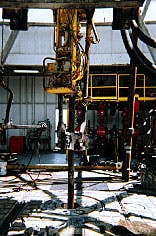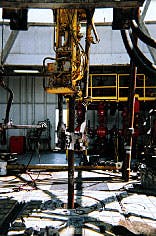Troy Whittington
Unocal USA
Lafayette, La.
Arno Op De Weegh
Noble Engineering & Development Ltd.
Houston
Noble Drilling Corp.'s Tom Jobe, on location for Spirit 76 (a business unit of Unocal Corp.) in Mobile Bay, used a unique method for optimizing penetration rates and reducing drillstring failures by balancing rotary speed and torque parameters. Photo by Arno Op De WeeghThe relationship between rotary speed and drilling torque can be used to optimize penetration rates while reducing drillstring failures.
An in-house software program, used to graph drilling data on a second-by-second basis, can recognize conflicts or disharmonies between recorded rotary speed and torque. Based on present available polycrystalline diamond compact (PDC) bit data, two conclusions can be made:
First, the wrong combination of rotary speed and bit weight, as applied to various formations, can create high-amplitude, low-torque characteristics (Fig. 1 [77,413 bytes]). This condition can generate harmful stresses to the drillstring.
In these cases, destructive action occurs because the transfer of drilling torque to the bit causes a partial conflict between rotational speed and torque frequency. Thus, it becomes important to align both parameters, drilling torque and rotary speed, to create the most efficient cutting energy possible.
On the other hand, high-steady torque characteristics can beneficially increase penetration rates (Fig. 1). This occurs because all of the energy (torque) is used to make hole. In addition, drillstring failures created by high-amplitude, low-torque characteristics, are minimized under these conditions.
This article contains information about torque variations and characteristics while drilling through Cretaceous formations in the Gulf of Mexico. A basic comparison is made between the drilling torque characteristics as experienced in the North Sea and the Gulf of Mexico. Recommendations are also presented to avoid string failures while drilling through these formations.
Drill graph system
Field trials of the drill graph system ( Fig. 2 [49,970 bytes]), developed by Noble Engineering & Development Ltd., were conducted on board several jack ups in the Gulf of Mexico. The first field trial, conducted on Unocal's Well No. OCS-G12114 in Mobile Bay (Fig. 3), drilled 121/4 and 81/2-in. hole sections below 12,000 ft in Cretaceous formations with mud densities exceeding 17 ppg.Chert beds
Within many areas of the North Sea, the Cretaceous Chalk group is well developed, usually consisting of closely cemented chalky and marly limestones that are low in terrigenous material and comprised mainly of pelagic calcareous fossils.A pronounced decrease in the gamma ray, marked by an increase in the induction and sonic log readings, denotes the bed boundary. Chert concentrations are common, usually forming layers parallel to the bedding plane. Along the basin margin, sand tongues are present as well as coarser bioclastic limestones.
The existence of the chert layers, deposited within the chalk group, is of particular interest when drilling the Cretaceous. Because these chert/chalk boundaries cannot be identified by seismic techniques, the present approach is to correlate lithologic logs from nearby wells in an attempt to avoid drilling into these sections. The chert-bearing layers are considered one of the reasons for string failures.
The Cretaceous Selma Chalk, located in the underlying strata of the Gulf of Mexico, typically consists of calcareous fossils including a sandy lithologic composition at the base of the formation. The existence of chert layers, as in the North Sea, are also considered to be one of the reasons for string failures.
The most common string failures in the North Sea and Gulf of Mexico include the following problems:
- Washouts in drill pipe, heavy-weight drill pipe, and bottom hole assemblies
- Twist offs of bottom hole assemblies and heavy-weight drill pipe.
- The use of large OD bottom hole assemblies
- The use of shock subs and soft torque systems
- Stabilized bottom hole assemblies
- Frequent bottom-hole assembly inspections
- The maintenance of drilling fluid pH values above 9.0
- Low rpm and torque values.
PDC torque variations
While drilling in the Gulf of Mexico (Mobile Bay Block 918), Noble's in-house drill graph system recorded and graphed two different torque characteristics (Fig. 1):- High-amplitude, low-torque readings measured between 120 and 450 amp at 60-80 rpm.
- Steady, high-torque readings measured between 450 and 650 amp at 70-90 rpm.
High-amplitude, low torque
High-amplitude, low-torque characteristics exhibit "slip-stick" torque attributes, resulting from a high number of torque returns once the rotary table or top drive comes to a stop. Critical rotational velocities are thought to create these high-amplitude, low-torque attributes. Conversely, low-average torque characteristics can be regarded a beneficial in relation to the avoidance of drillstring failures.Fig. 4 [180,616 bytes] illustrates high-amplitude, low-torque characteristics with bit weight on the primary axis and torque values on the secondary axis.
A detailed focus on torque, as shown in the conflict or overlap between rpm and torque in Fig. 5 [32,007 bytes], indicates a misalignment between rotary speed and drilling torque, considered to be the initiator of bit bouncing, low drilling rate, and high-amplitude, low-torque characteristics.
Steady high torque
Steady high torque values could be considered to be a primary reason for drillstring failures and should be avoided while drilling. These characteristics are portrayed by a low number of torque returns once the rotary or top drive is stopped. Steady high torque characteristics can be obtained through high rotational velocities as illustrated in Fig. 6 [63,243 bytes] where the rpm values are located on the primary axis and torque values on the secondary axis.A detailed focus, in seconds of torque as shown in Fig. 7 [33,757 bytes], indicates no conflict, or overlap, between drilling torque and rotational speed. This improves the cutting pattern between the formation and bit, indicating that the majority of torque is expended at the bit face and not the borehole wall. This explains the higher penetration rates and limited number of torque returns once rotation is stopped.
String failures, recommendations
Drilling with high-amplitude, low-torque characteristics, to depths of 12,000 ft, has resulted in three drillstring wash outs and one twist off. Bits pulled in these sections showed heavy wear conditions. However, drilling hole sections with steady high-torque values resulted in zero string failures between 12,000 and 15,500 ft. PDC bits pulled in these sections showed normal wear conditions.Based on experience, the following standard procedures for PDC bits were developed to avoid high-amplitude, low-torque characteristics while drilling in Mobile Bay. First, it is recommended that the driller establish a high rotational speed after a connection is made to produce a steady torque reading.
During the drilling operation, the rotational speed can be readjusted for optimum penetration rates. In case high-amplitude, low-torque values are again detected while drilling, the drillstring should be picked up off bottom, then the driller should repeat the start-up procedure as discussed above (Fig. 8 [94,635 bytes]).
It should be noted that more data will be required from future wells, using different bit types, to conclude if identical torque characteristics are present and whether procedures can be developed to change torque characteristics.
Acknowledgment
The authors gratefully acknowledges the support and assistance of "Buddy" King, Don Sparling, and Mitchell Pinckard of Noble Engineering & Development Ltd., without whose efforts this work would not have been accomplished.The Authors
Troy Whittington is a drilling foreman for Unocal Corp. (Spirit Energy 76), currently working in Mobile Bay. He has been with Unocal since 1992. Whittington is a graduate of Louisiana State University in Baton Rouge, La., and holds a degree in petroleum engineering.
Arno Op De Weegh is vice-president of business development for Noble Engineering & Development Ltd. He has 35 years' experience in various management functions of drilling and subsea engineering. Op De Weegh is a graduate of the Drilling Engineering School in Celle, Germany.
Copyright 1999 Oil & Gas Journal. All Rights Reserved.





